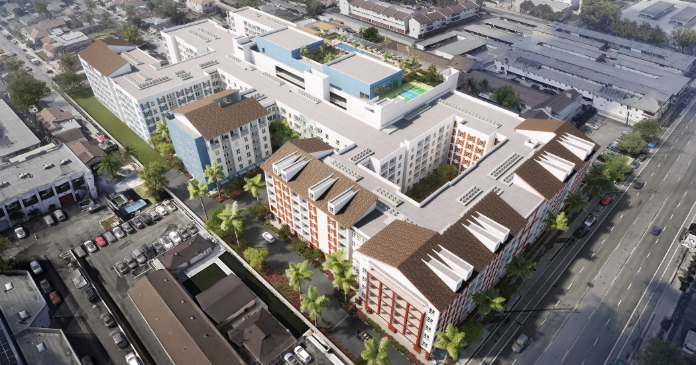Edgy clubhouses, outdoor spaces, state-of-the-art fitness centers, the latest in technology and a range of floor plans all are signatures of the Houston-based luxury apartment developer.
The Morgan Group (MGI) is on a roll. With 5,000 units in various stages of development on both coasts and a few markets in between, the company is ramping up to ride a tailwind of demand from renters- by-choice and empty nesters, echo boomers entering the workforce and young professionals priced (for now) out of the single-family home market.
“The Morgan Group has had two lives. It also was the name of our father’s company,” said Michael. The name is the same, but the business differs dramatically from the Morgan Group founded in Houston by William J. Morgan in 1959. “My father was an investment builder of apartments and warehouses, who never ventured outside his local market. He never had partners and never sold until the early 1980s.” But Houston marches to the beat of an oil drum and by the mid-1980s, that beat was faint indeed. The energy industry collapsed and the bottom fell out of the oil economy, driving the entire area into a deep recession. The senior Morgan was fortunate to have sold most of his properties before the real estate crash. He retired in 1986.
A new direction
Michael and Ronnie, who grew up working in construction, brought back the Morgan Group name and incorporated it three years later. Needing money to finance their projects, the brothers turned to pension funds and REITs for equity financing. “We have properties we’ve funded ourselves, but for the most part, our partners provide the capital and we provide the opportunity and development expertise,” said Michael.
By the time market fundamentals began improving in Houston in 1990, MGI already was underway on its first project — the 204-unit Inverness, a partnership with Martin Fein Interests, located inside the loop between the Galleria and Downtown. Michael, however, had no intention of repeating the mistakes he’d watched others make in the past. “I noticed a lot of developers suffered financially, mostly because they weren’t diversified geographically and didn’t have strong capital structures that de-leveraged their properties. My brother and I wanted to combine geographical diversity, strong locations around employment centers, quality projects and a strong capital structure,” he said.
After completing its second apartment project, the 228-unit Memorial in Houston, MGI entered Denver in 1991, becoming one of the first developers to build into that market’s recovery. “We wanted to be in cities where the economy hadn’t fully recovered yet,” said Michael. MGI subsequently moved on to develop in Tucson, Fort Lauderdale, Nashville, Kansas City and San Diego, finally returning to its hometown in 1997 to purchase a parcel in the Energy Corridor from Chevron Real Estate that the Morgan brothers had been eyeing for years. They never developed the site. A window of opportunity opened up in the Energy Corridor for office development in 1998, and MGI sold the land to Tishman Speyer, but went on to build nine luxury communities at other locations in Houston.
“We’ve developed more than 11,000 units nationwide and, considering we really started focusing on high-end multifamily rentals in 1989, I’m really proud of that,” said Michael. For the first six years, he and Ronnie did it all. They worked entitlements, hired architects, sat in on all planning commission meetings and hired leasing staff. “We were always running. There was so much work we could only do two to three deals a year,” said Ronnie. As the company grew, the brothers added stronger management and gave up some of the action to their operations personnel and development partners.
About the time MGI returned to Houston, the company brought on Alan Patton as president, who hired Stan Levy as COO/CFO several years later. Louis Kuntz, acting as development partner, started three projects in San Diego and, soon thereafter, Ronnie moved to California. “We were again witnessing the recovery in California and knew the market was going to continue to turn. We asked Louis to make a permanent move to the West Coast to help grow our presence,” said Ronnie, who still lives in the Golden State.
Houston is the location of the company’s headquarters, but MGI also has offices in Carlsbad, Calif., and Orlando, Fla. “We learned over time, after one-hopping into many markets, we should drop anchor in a few,” he said. With longer entitlement periods and construction time frames and stubbornly high construction costs, MGI buys land to use, not to hold.
Mid-rises can cost between $150,000 and $400,000/unit to build, depending on the market and the design. “Ours are either podium, with parking as part of the foundation structure underneath the building, or a wrap product where the apartments wrap around a separate parking structure, which costs less,” said Michael, adding that California is MGI’s most expensive market. “The good news is material and construction costs in our regions seem to have peaked for now. I just returned from Orlando, where our framer was telling me he’s finding all the 10-man crews he needs because homebuilding has screeched to a halt,” said Michael.
MGI didn’t participate in the condo conversion craze or build ground- up condos. “There was a lot of temptation, but I started in the for- sale business in 1984 and, after three projects I decided it was not for me. I’m very proud of our group for sticking to its knitting. We took advantage of selling land and properties to condo developers over the past 18 months,” Michael said.
MGI is working on around a dozen high-density projects, including a couple of mixed-use developments in the Golden State that feature MGI’s signature amenity package and custom-home-like designer interiors. The 362-unit Triana at Warner Center is rising in the super hot Warner Center area on the site of two former office buildings that MGI bought for $30 million in 2003 and razed for the project. The company went under contract just 18 months ago on a 3.24- acre site in Glendora and hopes to be underway on the 172-unit Sevilla by fall — a feat of some magnitude in California, where the entitlement process can take up to four or five years.
MGI also is gearing up to start 320 luxury units on a six-acre former rail yard in the River Market sub-market of Kansas City that the company bought from Kansas City Southern for $4.93 million. Yet another project is the 322-unit Lofts at South End, a transit- oriented mix of conventional and loft-style units in Charlotte, N.C. MGI recently paid $6.2 million for the almost five-acre former Sonoco packing plant site in Charlotte’s South End neighborhood.
The 300-unit Totem Lake Mall apartments in Kirkland, Wash., represents MGI’s first project in the Seattle area and the company’s first transaction and co-development with Developers Diversified. MGI is purchasing air rights as part of the development. And the company will add much needed luxury rental supply to Jacksonville’s Southside when it breaks ground on the 756-unit Pointe at James Island this summer.
MGI recently sold more than $500 million in properties and continues to manage a number of them. “We’ve generally held properties from three to seven years and have had some pre-sales to REITs and pension funds, but we also continue to own. It really is on a case-by-case basis and depends upon our capital structure with our equity partners,” he said.
















